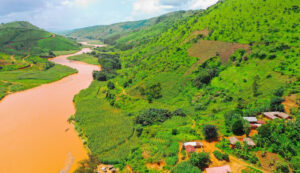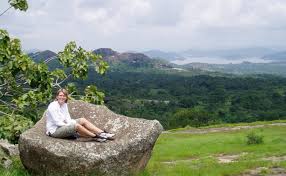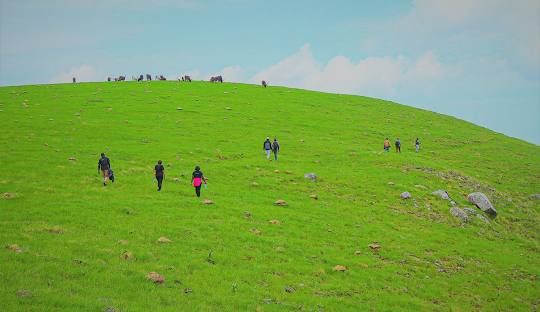The Mambilla Plateau is a plateau in the Taraba State of Nigeria. The Mambilla Plateau has an average elevation of about 1,600 metres (5,249 ft) above sea level, making it the highest plateau in Nigeria. Some of its villages are situated on hills that are at least 1,828 metres (5,997 ft) above sea level. Some mountains on the plateau and around it are over 2,000 metres (6,562 ft) high, like Gang or Chappal Waddi which has a height of 2,419 metres (7,936 ft) above sea level. It is the highest mountain in Nigeria and in West Africa. The Mambilla Plateau measures about 96 km (60 mi) along its curved length; it is 40 km (25 mi) wide and is bounded by an escarpment that is about 900 m (2,953 ft) high in some places. The plateau covers an area of over 9,389 square kilometers (3,625 sq mi).
A Journey to the Top: Reaching the Plateau
Ascending to the Mambilla Plateau is an adventure in itself. The journey winds through winding roads that reveal panoramic views of rolling hills and verdant valleys. As you climb higher, the air becomes crisper, and the landscape transforms, setting the stage for the natural wonders that await at the summit.
Travel Guide? Click here to see one: https://www.youtube.com/watch?v=OitSntxomQ4
Geography

The Mambilla Plateau is located in the southeastern part of Taraba State of Nigeria under Sardauna local government area.
The Mambilla Plateau constitutes one of Taraba State’s largest local government areas. There are numerous towns on the plateau,
with the largest being Gembu. The plateau has its south and eastern escarpments standing along the Cameroonian border, while the remainder of its northern escarpment and its western slope are in Nigeria. The Mambilla Plateau is hilly with deep gorges, and
travelers are constantly passing from one panoramic view to the other. The plateau is entirely covered by soil with occasional occurrence of granite. The plateau is dissected by many streams, notably the Donga River and Taraba River, with both having their sources
on/from the Mambilla Plateau.
The Mambilla Hydroelectric Power Station is proposed for construction in Western Mambilla near the Nigeria-Cameroon border,
within an anticipated completion date of 2030, although it has been on the drawing boards for upwards of 48 years. Nigeria’s largest game reserve, the Gashaka/Gumti Game Reserve, is located north of Chappal Waddi on the northern border of the Mambilla Plateau.
Climate
The climate of the plateau is comparatively cold. Daytime temperatures hardly ever exceed 25 °C (77.0 °F) making it the coolest region in Nigeria. Strong winds prevail during the daytime and the rainy season lasts from mid-March until the end of November. As a result
of its high elevation, the plateau experiences temperate weather conditions but on a smaller scale because of its location in a tropical environment. The rainy season on the Mambilla Plateau is associated with frequent and heavy rainfall because of orographic
activities on the plateau involving moist winds from the south Atlantic Ocean in southern Nigeria and the steep escarpments of the plateau. The Mambilla Plateau receives over 1850 millimetres of rainfall annually.

Vegetation
Vegetation on the plateau comprises low grasses with trees being noticeably absent except for man-made forest planted by German colonialists during the period of German administration of the Cameroons (c. 1906-1915) and other Nigerian government tree planting programs. The predominant vegetation cover is the low, velvet grass akin to the English rat-tail grass, known locally here as “gwur” grass.
It is a major ritual emblem of the local traditional religion. The plateau is the only region of Nigeria that grows the tea plant on a large scale and there are several tea farms, although the sector remains mostly underdeveloped.
It is also home to the Gashaka Gumti National Park, which is the largest national park and protected area in all of Nigeria,
as well as the Majang Forest known officially as Ngel Nyaki Forest Reserve, both of which harbor rare and endangered West/Central African plant and animal species endemic to the area.The eucalyptus tree is the dominant tree is these man made forests as a result of the easily adaptability of the eucalyptus tree to the height and the cool climatic conditions on the plateau. The abundance of low lush green grasses on the plateau has attracted a large number of cattle, whose advent beginning during British rule affected the plateau’s vegetation. This has resulted in overgrazing and widespread erosion on the plateau and has created problems between the cattle herders, referred to as the Fulanis and the indigenous people, the Mambila.
The plateau’s scenery is nothing short of spectacular. Lush green fields stretch as far as the eye can see, interspersed with towering trees and pristine waterfalls. The landscape is a mosaic of natural beauty, offering numerous opportunities for hiking, photography, and simply soaking in the serene environment.
Agricultural Abundance: The Plateau’s Bounty
The fertile soils and favorable climate of the Mambilla Plateau make it an agricultural powerhouse. The region is renowned for
its tea and coffee plantations, which thrive in the cool temperatures. Visitors can tour these plantations to see the cultivation process firsthand and even sample the local produce.
In addition to tea and coffee, the plateau is a rich source of fruits and vegetables. The abundant pastures also support livestock farming, particularly cattle, making dairy products another highlight of the region’s offerings.
Tourism Potential: Attractions and Activities
While the Mambilla Plateau may not be as developed as other tourist destinations, its natural attractions make it a worthwhile visit. Key highlights include:
Chappal Waddi: Standing at 2,419 meters (7,936 feet), Chappal Waddi is the highest peak in Nigeria. Hiking to its summit rewards adventurers with stunning views and a sense of accomplishment.
Gashaka-Gumti National Park: Partially located on the plateau, this national park is Nigeria’s largest and is home to diverse wildlife, including chimpanzees, leopards, and various bird species.
Waterfalls: The plateau is dotted with beautiful waterfalls, such as the Barup Waterfall, which provide perfect spots for picnicking and relaxation.
The Mambilla people offer a rich heritage with their traditional dances, music, and crafts. Engaging with the local communities provides a deeper understanding of the plateau’s cultural landscape.
Hydropower Potential: Energy for the Future
The Mambilla Plateau is not only a place of natural beauty but also a potential powerhouse. The rivers and waterfalls in the region have significant hydropower potential. The ambitious Mambilla Hydroelectric Power Project aims to harness this potential,
with plans to generate over 3,000 megawatts of electricity, making it one of Africa’s largest hydropower projects. This development
promises to bring significant economic benefits and energy solutions to Nigeria.

In Conclusion
The rest of the new entrants lay no claim to ancestral lands, but are business or occupational migrants without ancient or
ancestral villages of their own. All Banso and Kambu (Wimbum) villages are to be found only in Cameroon Republic, some quite
distant from the Nigerian border. The vast majority of the people of Mambilla Plateau speak Mambilla as their first language.
English is the official language today, while Fulfulde (language of the Fulani, introduced in British times) has been
employed as trade language in modern times.
Christianity and Islam are the main religions today, having gradually displaced the Mambilla Traditional Religion that was based
on the Suu system, which was the predominant religion before the coming of Christian missionaries (from the 1920s) and Hausa and Wawa itinerants. These new religions became particularly visible after the 1960s.
Whether you’re an adventurer, a nature lover, or simply seeking a peaceful retreat, the Mambilla Plateau offers something special. Its unique combination of climate, scenery, and culture makes it a destination worth exploring.
Pack your bags, lace up your hiking boots, and get ready to discover the hidden gem
of Nigeria—the enchanting Mambilla Plateau.
Read more: https://placesandlifestyle.com/enchantment-of-obudu-mountain-resort/




